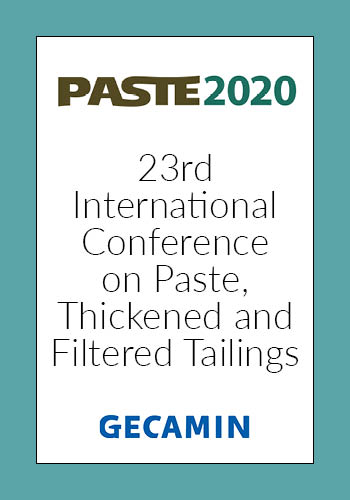Inline Characterization of mining slurries by Ultrasonic velocity profile technique (UVP)

|
Authors: Montes-Quiróz, W; Garrido, P; Moscoso, C |
DOI https://doi.org/10.36487/ACG_repo/2052_15
Cite As:
Montes-Quiróz, W, Garrido, P & Moscoso, C 2020, 'Inline Characterization of mining slurries by Ultrasonic velocity profile technique (UVP)', in H Quelopana (ed.), Paste 2020: 23rd International Conference on Paste, Thickened and Filtered Tailings, Gecamin Publications, Santiago, https://doi.org/10.36487/ACG_repo/2052_15
Abstract:
It has been determined, after a technical feasibility study, that ultrasonic is the best alternative to characterize slurry flows in tailings flumes, by using the “Ultrasonic Velocity Profile” (UVP) technique, which among its many advantages it has shown not to be invasive, to have a high sample frequency, to have the ability to make measurements in opaque means, to have portability, and also that its implementation in existing structures is not complex, nor that it requires special permissions like other technologies do (based on radiation). In the Investigation Centre JRI (CI-JRI), two measurement UVP’s prototypes have been designed, built and set up in transport systems of flumes on a laboratory scale. These prototypes have also been able to perform ultrasonic measurements that have got to a correct estimation of the velocity profile, together with an ad hoc post-processing methodology, outcomes that allow projecting applications at an industrial level and that would generate meaningful benefits in the operation. The future challenges aim to higher scale tests and the development of a given post-processing methodology that would let determine inline, and with a precision over 1%, associated values to the concentration of solids in the fluid, the velocity profile of the fluid in the flume and rheological parameters, all essential to a correct controlling of stages in the transportation of tailing slurries with high concentration.
References:
Southard, J. 2006 ‘Chapter 4, Flow in Pipes and Channels, in Introduction to Fluid Motions, Sediment Transport, and Currents Ge nerated Sedimentary Structures ‘, fall 2006, MIT Course Number 10090, USA
Wiklund J. and Stading M. 2007, ‘Application of in-line ultrasound Doppler-based UVP-PD rheometry’, Flow Measurement and Instrumentation, Vol 19, pp 171-179.
Kotzé R., Wiklund J. and Haldenwang R. 2016 ‘Application of Ultrasound Doppler Technique for In-Line Rheological Characterization and Flow Visualization of Concentrated Suspensions’, The Canadian Journal of Chemical Engineering, Vol 94, pp 1066-1075.
Martín Rodriguez P., Martín Rodriguez E. 2014 ‘Utilización de anemómetro de hilo caliente a temperature constant para mediciones de velocidad de aire en túnel de viento’, Ingeniería Electrónica, Automática y Comunicaciones, Vol 35, n°1, pp 78-92.
Powel R. 2008 ‘Experimental techniques for multiphase flows’, PHYSICS OF FLUIDS, Vol 20, pp 040605(1)-040605(2).
Y. Takeda, ‘Ultrasonic Doppler method for velocity profile measurement in fluid dynamics and fluid engineering ‘, International Journal of Heat and Fluid Flow, Vol 7, pp 313-318, 1985.
Rahman M and Hakansson U. 2011 ‘In-Line Rheological Measurements of Cement Based Grout Using The UVP-PR Method ‘, 1, Rock Engineering Research Foundation, Stockholm
Takeda Y. 1995 ‘Velocity Profile Measurement by Ultrasonic Doppler Method’, Experimental Thermal and Fluid Science, pp 444-459.
Kotzé R., Wiklund J. and Haldenwang R. 216 ‘Application of Ultrasound Doppler Technique for In-Lene Rheological Characterization and Flow Visualization of concentrated suspensions’, The Canadian Journal of Chemical Engineering, Vol 94, pp 1066-1075
Kirkhorn J. 1999 Introduction to IQ-Demodulation of RF-data.
Benedito J. 2003 ‘Use of ultrasonics for the composition assessment of olive mill wastewater (alpechin)’, Food Research International, n°37 pp 595-601.
© Copyright 2026, Australian Centre for Geomechanics (ACG), The University of Western Australia. All rights reserved.
View copyright/legal information
Please direct any queries or error reports to repository-acg@uwa.edu.au
View copyright/legal information
Please direct any queries or error reports to repository-acg@uwa.edu.au